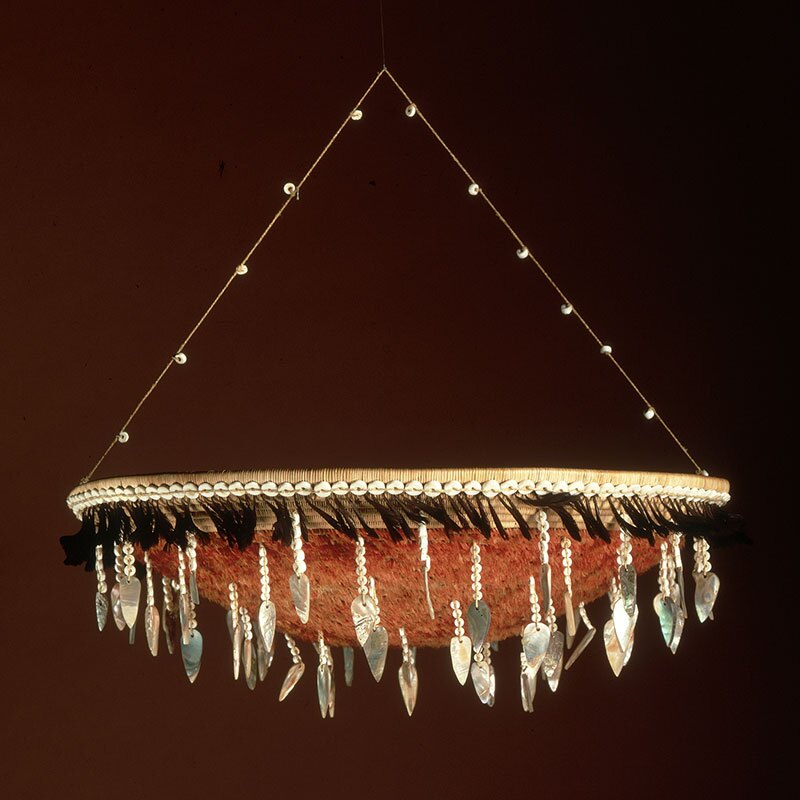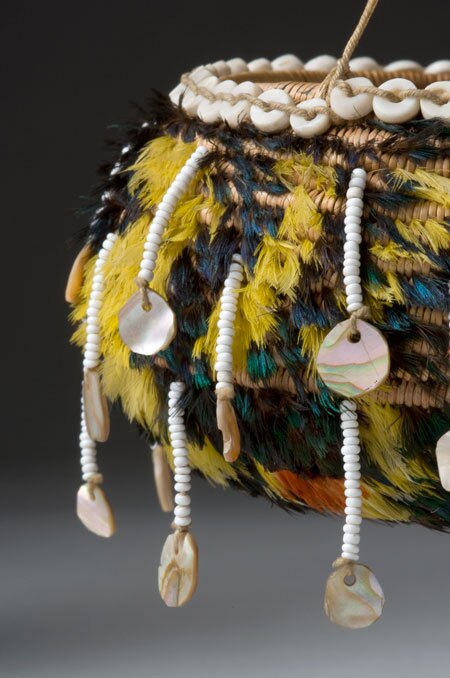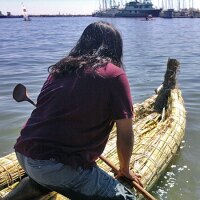Weaving With Feathers in the 'Silent Spring' Era


Watch our documentary Tending The Wild on KCET TV, February 7 at 9:00 p.m.
One of the most astounding aspects of California Indian art and material culture is the diversity of natural materials used by makers and artists. For thousands of years, Native people in California have used elements from their local environments to create basketry, clothing, jewelry, and more. These materials include a variety of plant species found across the state, along with shell, steatite, clay, bone, elk horn, hide, and porcupine quills, to name just a few. For many of the tribes in Central California, including the Pomo, one of the most important materials is feathers.
Pomo weavers and regalia makers use feathers for basketry and attire worn during dances and other ceremonial occasions. These birds were part of the vast environmental diversity of the ancestral Pomo homeland. Prior to contact, the Pomo communities lived off of an abundance of animal and plant life, from shellfish and seaweed along the coast to deer and acorn in the valleys. Oak groves provided food and shelter for acorn woodpeckers and other bird species.
In the last two centuries, California's birds have suffered along with their habitat. But rather than abandon an important aspect of their culture, Native artisans are finding new ways to obtain feathers that don't further harm the wild birds with whom they share their home.
Pomo weavers have had a long-standing relationship with birds. For baskets, Pomo weavers traditionally used feathers from multiple bird species, including western meadowlark, oriole, mallard duck, acorn woodpecker, pileated woodpecker, western bluebird, and California quail. Exquisite fully feathered baskets, sometimes called fancy baskets or jewel baskets, were traditionally intended to be given as gifts to mark weddings or other ceremonial and special occasions. They were also used at funerals, where they would be burned or buried with the individual. Feather baskets were often also adorned with clamshell and abalone shell, which had to be drilled and ground by hand. Sun baskets were shallow bowl-shaped baskets covered in red woodpecker feathers, intended to be hung from a fine cordage strap, allowing light to glint off dangling abalone shell pendants.

When making feather baskets, weavers insert the shafts, or quills, between stitches of sedge root, which are pulled tight to hold the feathers in place. Some weavers use a technique called “spot feathering,” where small feathers (usually acorn woodpecker) are scattered broadly across the surface of a basket. Others are fully feathered; when the weaver is finished, the rows of coiled sedge are completely covered in bright, iridescent colors from various bird species.
Some of the feathers are exceptionally tiny. In The Fine Art of California Indian Basketry, author and basketry scholar Brian Bibby describes this delicate work, explaining that “there are special techniques for working with feathers, especially the crest feathers of the acorn woodpecker, which are very small, only about three-eighths of an inch in length.”
By the turn of the twentieth century, Pomo feather baskets were especially prized by collectors. During the period of “salvage ethnography,” anthropologists, curators, and enthusiasts rushed to preserve what they inappropriately referred to as vanishing traditions. During that time, beautiful feather baskets were made often made for sale. Today, however, many weavers continue the tradition of giving them as gifts for special occasions.
Although birds were trapped and hunted for feather basketry, their other parts were not wasted. Mabel McKay, the esteemed Pomo weaver who was especially known for her feather work, emphasized that birds used for feather basketry should also be eaten. In a rare film recording of Mabel, which is now housed at Chico State University as part of the Dorothy Hill Archive, she describes her feather baskets: “I get most of my enjoyment working with the feathers. The bird is very sacred to us. Also, the tradition weavers, when they weave their baskets, when they kill their own birds, they eat the birds. The do not let it spoil.” Mabel frequently relied on roadkill to obtain enough feathers for her work.

The use of feathers extends well beyond basketry in Pomo material culture; beautiful regalia items — skirts, headdresses, hair pins, ear tubes, and more — are often adorned with feathers. Men and women wear different regalia. Traditional men’s attire includes flicker-feather headdresses made from the quills of the common flicker. Many male dancers wear these headdresses at Big Time gatherings or other dances today. Pomo doctors, or traditional healers, also wore flicker-feather headdresses. Women often wore feather headpieces made of crow feathers and cordage, which would be inserted with a wooden hair pin into a bun piled on top of the head. For regalia makers, constructing these headdresses required in-depth knowledge of and respect for both the plant and animal life in the area.
Earlier generations could hunt birds to obtain feathers they needed for basketry and regalia. The birds served as food, and were also more plentiful without all of the other environmental pressures affecting the landscape today. Nowadays many of these bird species are threatened by habitat loss due to urban development. In Pomo territory the loss of oak woodlands has led to a decline in many of the bird species used in basketry, most notably the acorn woodpecker. Pesticide use has also contributed to the decline of many of these birds.
Over the course of the twentieth century, bird species declined drastically across the country, due to a variety of environmental factors. This loss prompted the passage of several laws, including the Migratory Bird Treaty Act. The law was originally passed in 1918, following the tragic extinction of species such as the Passenger Pigeon and the Carolina Parakeet due to commercial overhunting. Today, habitat loss and pollution are the primary threats to birds protected under the act. The Migratory Bird Treaty Act is enforced by the U.S. Fish and Wildlife Service, whose website states that the act “makes it illegal for anyone to take, possess, import, export, transport, sell, purchase, barter, or offer for sale, purchase, or barter, any migratory bird, or the parts, nests, or eggs of such a bird except under the terms of a valid permit issued pursuant to Federal regulations.”
Today, weavers and regalia makers are faced with the challenge of protecting threatened bird species while also ensuring that their cultural traditions are not lost. Contemporary artists often look at older examples of objects in museum collections to document which bird species were traditionally used and adapt their methods to continue their work. Roadkill and trade are now common ways to collect feathers. For example, Nomsoos-Nomtipom Wintu regalia maker Kai LaPena created a contemporary Pomo women’s crow feather dance headdress (or “ladies hat”) for The Life and Work of Mabel McKay exhibition at the Autry Museum of the American West, referencing an older example in the collection from the 1860s that the conservator deemed too fragile to display. He used raven, turkey vulture, and crow feathers, nothing that “all feathers used [were] received through trade and gifts.”

Dry Creek Pomo weaver Clint McKay relays challenges that contemporary weavers face today to maintain the tradition of feather basketry. Today, there are multiple restrictions on the bird feathers weavers are able to collect, and in which seasons they may gather them. Clint, along with other weavers, is registered through the federal government with a special permit to be able to possess feathers from restricted or endangered birds. While this permit does not necessarily allow the hunting of birds, it does allow him to possess the feathers, which he often obtains from roadkill. Government agencies that receive dead birds or feathers will also occasionally distribute them to permit holders on a wait list.
Weavers have also adapted the types of feathers they use in contemporary baskets. Some use non-traditional feathers, from species that weren’t originally native to California. For example, pheasant feathers are sometimes used in feather baskets, replacing feathers from traditional birds like orioles and meadowlarks. Others used dyed chicken feathers, or even feathers from domesticated birds. Some individuals with pet birds such as parakeets make use of the feathers once the pets have lived out their lives.
Ultimately, weavers and regalia makers today are trying to innovate to maintain their traditions. Clint McKay emphasizes the importance of feather baskets to his community. “The feather basket gets to the heart of our cultures and our traditions," he says. "If we lose that, we lose a significant part of our religious practices, and a portion of our ceremonies cannot continue without feather baskets.” For many of the materials used by Native California peoples — feathers and others — changing environmental factors have affected cultural practice, and they are seeking new ways to both preserve tradition and protect natural resources.
Banner: Black feathers. Photo: Will 668, some rights reserved.

Co-produced by KCETLink and the Autry Museum of the American West, the Tending the Wild series is presented in association with the Autry's groundbreaking California Continued exhibition.


